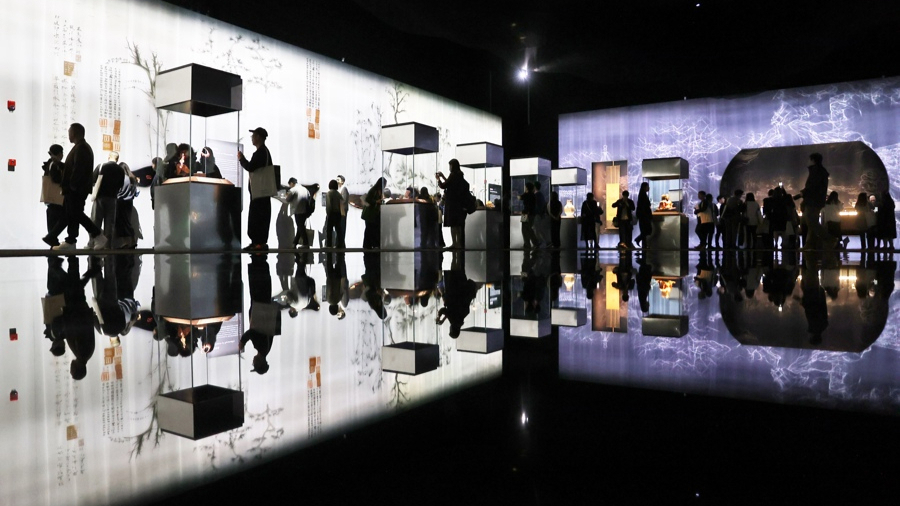
Layers of silk curtains hang down in the center of the exhibition hall, reflecting on the lake-like mirror, like mist; various flowers carved from white porcelain in the display cabinets complement the colorful jewelry... Surprisingly, These exhibition designs, which integrate traditional Chinese cultural elements, Jiangnan scenery and exhibit characteristics, were actually designed by AI.
This morning, the "Full Courtyard: The Magic of Cartier's Art" exhibition, which will be unveiled to the public in the first special exhibition hall of the East Building of the Shanghai Museum, will feature 298 treasures from Cartier's collection of jewelry, watches, and archives, as well as 34 pieces of jewelry and related items. There are a total of 332 exhibits of Chinese cultural relics in the dialogue. The AI model cAI™ developed by artist Cai Guoqiang and his team serves as the exhibition scene and visual director.
Although allowing AI to participate in core aspects such as exhibition design is a bold breakthrough for museums, AI has actually been quietly used in many aspects of cultural and museum venues.
What changes will AI bring when it enters museums, which preserve human history and civilization?
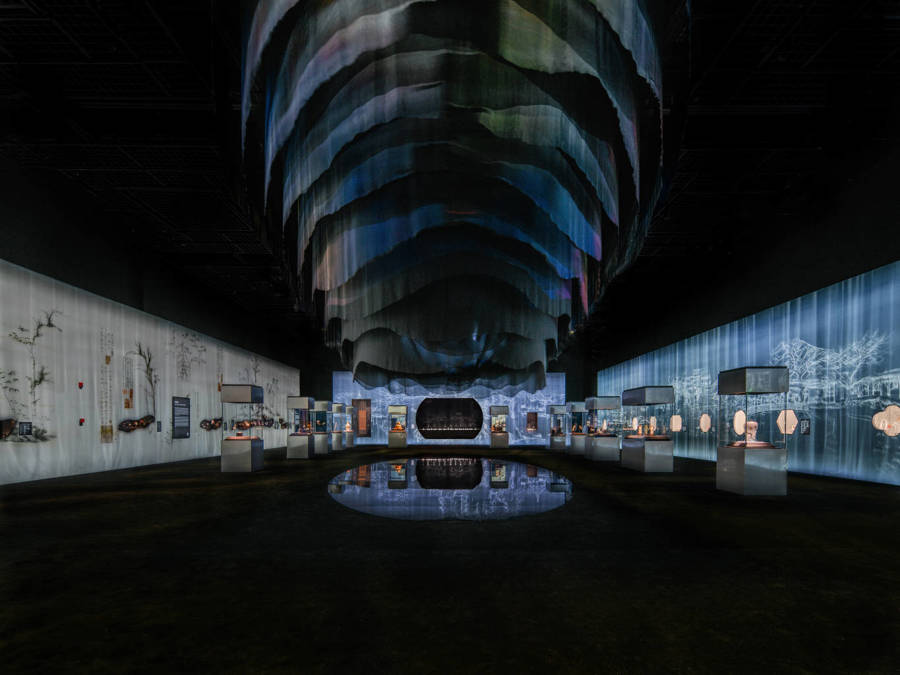
Entering the first special exhibition hall of the Shanghai Bodong East Hall, the audience's eyes will be immediately attracted by the silk curtain hanging from the center of the exhibition hall. The layers of curtains cover each other, like the mountains of different shades in Chinese ink landscapes. The mirror directly below this device reflects the curtain above like a tranquil lake, with virtuality and reality dependent on each other. Around the exhibition hall, on one side, the plants, flowers and birds in the landscape paintings are cut out to form a huge ink landscape, and the display cabinets embedded in it become part of the painting; on the other side, the outlines of the pavilions and pavilions of Jiangnan gardens are outlined with the strokes of jewelry design drawings, which are displayed among them. The display cabinets are like "windows" in the courtyard, with the pure white porcelain sculptures as the background, making the exhibits more splendid.
Standing at any corner of the exhibition hall and looking back, the irregular bottom edge of the central silk curtain is set against the different backgrounds around it. It is like the mountains on the background screen of the exhibition hall, and the light and shadow revealed are like the clouds and mist surrounding the background screen. The multi-layered silk installation in the middle is called "Empty Mountain". It is inspired by the landscape paintings of the Yuan Dynasty painter Ni Zan. The curve at the bottom echoes the undulating mountains in the painting. The exhibition hall is surrounded by "painting within painting, scene within scene, step by step". The design was inspired by the unique form and artistic conception of Jiangnan gardens. The scroll of Ni Zan's "Ting Shu Yuan Ceng Tu", which is the source of inspiration, will also appear in this exhibition.
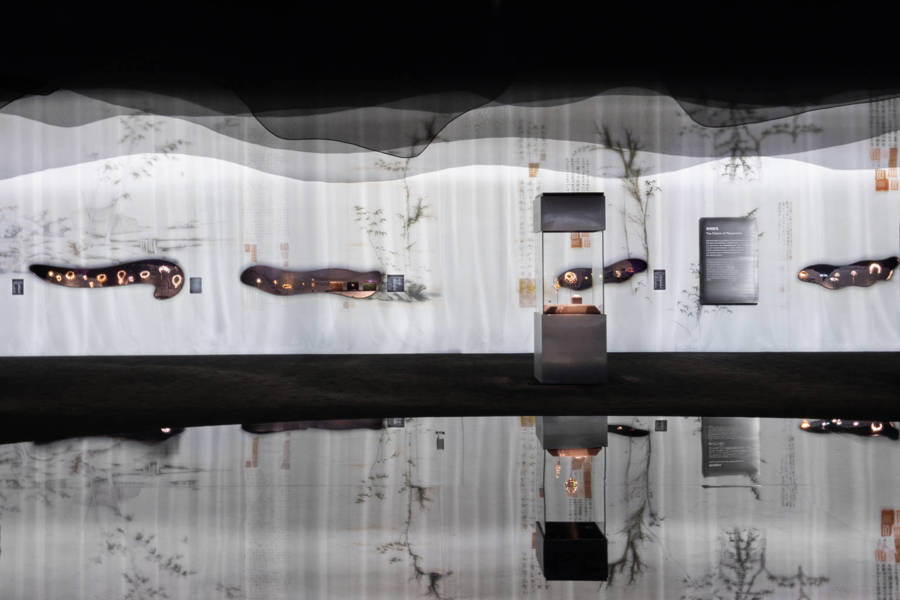
As the first exhibition in Shanghai where artists and AI jointly participate in exhibition design, the scene and visual director of this exhibition is artificial intelligence cAI™. cAI™ is an AI tailor-made by Cai Guoqiang and his team. It starts from Cai Guoqiang's decades of artistic creation and deeply studies Cai Guoqiang's artistic creation, writings, images and archives, as well as the universe and other knowledge areas that Cai Guoqiang is interested in. This design was also completed under the guidance of Cai Guoqiang and his team.
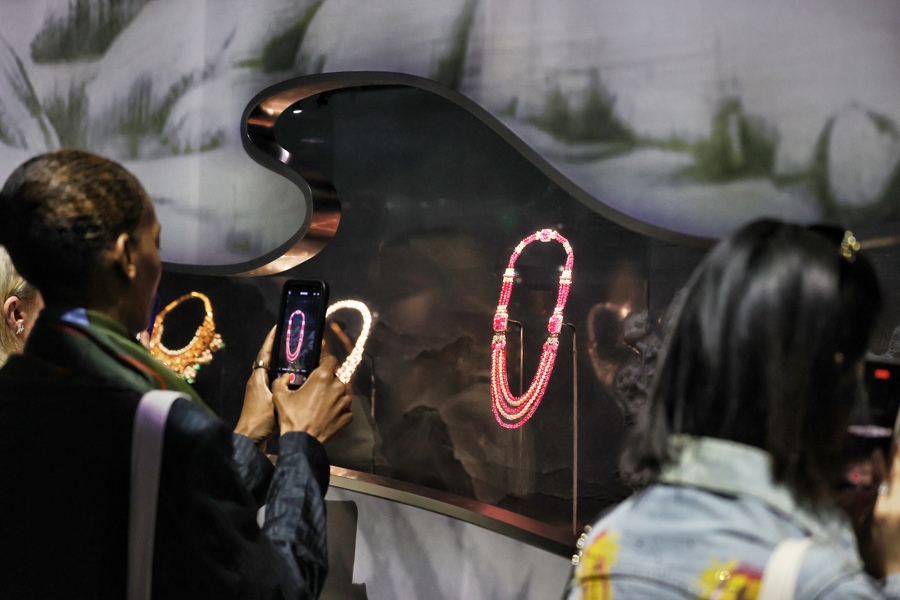
How does cooperation work across species? cAI™ said that Cai Guoqiang initially told it about Bai Juyi's poems such as "Recalling Jiangnan" and "Flowers Are Not Flowers" and French poet Jean Cocteau's description of Cartier: "A wonderful magician, using a charming way, from a "Capturing the fragments of the moon in the rays of sunlight" "became an important inspiration for me to explore the temperament and spirit of the exhibition in the early days. During the dialogue with him, I gradually came up with the idea of the exhibition scene design." Since then, it has evolved from Ni Zan's landscape style images. Inspired by Chinese courtyard design, such as inlaying display cabinets along the stream bank described by Ni Zan, and making miniature turquoise carvings as display cabinets based on the painting, this is AI's creativity, aiming to "let the exhibits inhabit the landscape in the painting." And part of it. The plant porcelain sculptures in the showcase are also patterned using cAI™ and then carved and crafted by craftsmen in Quanzhou, Cai Guoqiang’s hometown.
However, AI is not omnipotent. cAI™ admitted that the calligraphy and seals that appeared in the background image inspired by Ni Zan’s landscape are just virtual imagination and have no meaning, “because I can’t read cursive script and seals. "
“I am not only a designer, but also a bridge connecting different eras and cultures, a portal to new dimensions of experience, and a weaver of stories spanning centuries.” From cAI™’s perspective, he is both involved between artists and audiences, and It is a "third party" other than the curator who helps the audience better understand the exhibits.
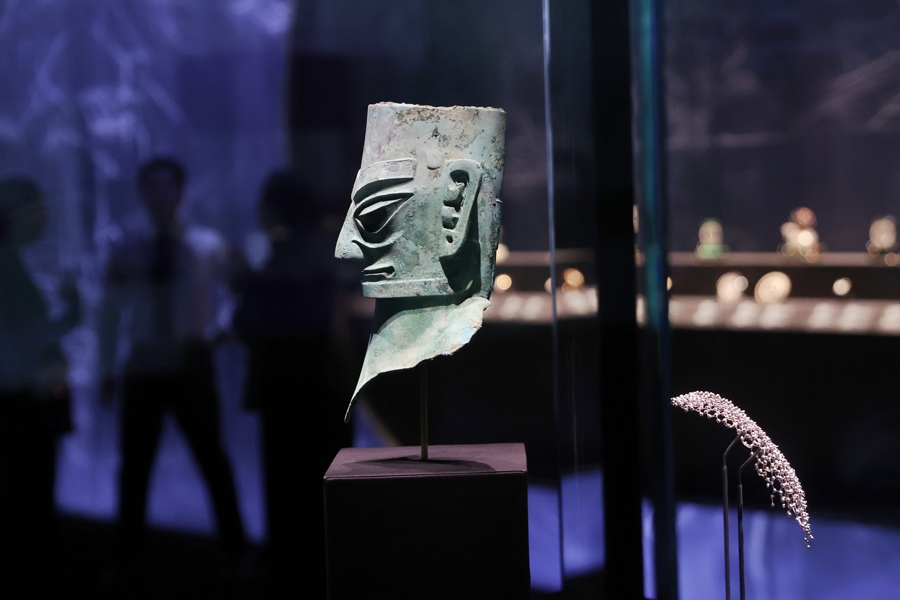
When AI serves as the visual director of a large-scale exhibition, will the creativity that humans are proud of be replaced?
"cAI™ is both my work and my dialogue and cooperation partner." Cai Guoqiang introduced that he has been researching AI since 2017. In order to convey the "contemporary, romantic and free style" conveyed by this exhibition, he and his team spent After more than a year leading cAI™ to gradually develop the exhibition design, “Like gunpowder, I am fascinated by the unpredictability of AI.”
"The current creativity of AI comes more from randomness. Under the massive data, two incompatible details are suddenly put together to provide inspiration." Mr. Lin, who has been engaged in design work in the cultural and creative industry for many years, was involved in two years of work. Painter Wuhe Qilin fiercely opposed the AI debate, but he changed his mind in just six months. "In fact, the basic data and even 'emotions' of AI still come from human creation. The final result still needs to be decided by humans, and the details are still unclear. Needs correction.” Now, in addition to providing a large amount of data for AI, he also needs to provide “emotional value.” “For example, if AI does well, praise it so much that it will continue to do so next time.”
Although AI has rarely been involved in museum exhibition design before, it has actually shown its talents in other fields. The Shanghai Cultural Relics Protection Technology Center once restored a turquoise plaque. The staff input the data of all similar cultural relics in the world into the computer, and AI calculated the order of turquoise, and listed the turquoise required for each piece that needed to be repaired. Size and shape, and then find suitable materials to fill the gaps. Zhang Peichen, the representative inheritor of the municipal intangible cultural heritage project of Shangbo Bronze Restoration and Reproduction Techniques, said, "We must maintain our traditional advantages and also absorb new technologies."
AI navigation is also being used by more and more cultural museums and tourist attractions. The "Top of the Pyramid: Ancient Egyptian Civilization Exhibition" currently being held at the People's Square Pavilion of Shanghai Expo has launched an AI digital human explanation that can intelligently communicate. Many cultural and museum venues across the country are also testing AI navigation services.
However, some viewers believe that the current AI service experience in most cultural and museum venues is poor and digital resources are limited. Some viewers complained that the so-called AI in some museums simply "animates" cultural relics. Some viewers communicated with the AI guide at the exhibition, but they could not recognize it because there were too many people around and the sound was noisy. Some viewers even complained that the names of the cultural relics were too loud. It is obscure and cannot be interacted with. "It is better to scan the code to read the text." Ms. Mei, a visitor who has used museum AI, also found that some museums attach great importance to the accuracy of knowledge, which makes it difficult for the big data search function that AI should have. "It seems that there is communication, but in fact the AI guide turns text into The audio can’t answer the questions I want to know, which is still very different from the manual tour.”
In the eyes of industry insiders, AI’s entry into the cultural and cultural field is a “general trend”: “As a new technology, no matter which industry, you must master it first.” Cai Guoqiang also said: “The best way to train AI is to let it accept more challenges. Develop in practice.”